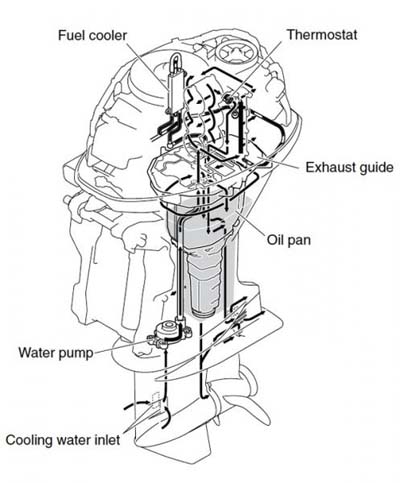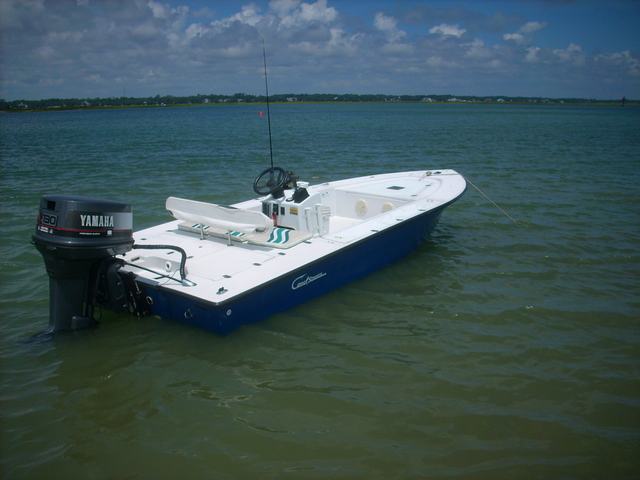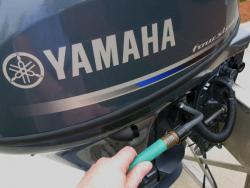The Boater’s Log – Yamaha
A day of sight fishing the flats is as good as it gets, but running in shallow water all day also creates perfect conditions for the cooling system to ingest mud, sand, and silt, which flows through the engine. Marine growth can occur behind the inlet screens and result in interrupting water flow to the engine. Over time, debris can accumulate in the outboard’s cooling passages. This build up can damage the water pump’s rubber impeller and plastic housing. Eventually, the buildup can also restrict the amount of water available to the engine resulting in poor cooling, which will damage the engine. It may even promote corrosion in the exhaust system because increased engine temperatures-along with the effects of using ethanol blended fuels-can cause increased exhaust temperatures.
[dropcap]A[/dropcap]dding years of life to an outboard is easy and doesn’t cost a dime. What’s the secret? Flush the outboard with fresh water frequently, preferably after every use. It’s that simple.
There are a couple of ways to cleanse the outboard: use the built-in freshwater flushing device fitting located on the lower cowling on most Yamaha outboards (doesn’t require running the outboard), or use a flushing attachment (flush muffs) to supply clean cooling water through the water inlets on the sides of the gearcase while the outboard is running.
Freshwater Flushing Device
 After boating and with the boat on the trailer, trim your Yamaha outboard all the way down, take the keys out of the ignition, and remove the safety lanyard. If the boat is moored or on a lift, the procedure is similar, but trim the outboard up until the gearcase is out of the water to allow fresh water from the garden hose to flow down through the water inlets on the gearcase. Unscrew the garden hose connector from the fitting on the lower cowling, hook up a hose to the connector, open the spigot and let the clean, fresh water wash the contaminants out of the outboard’s water passages for 10-15 minutes. Then turn off the water, disconnect the hose from the connector, screw the garden hose connector back on the fitting, roll up the hose — and the job is finished.
After boating and with the boat on the trailer, trim your Yamaha outboard all the way down, take the keys out of the ignition, and remove the safety lanyard. If the boat is moored or on a lift, the procedure is similar, but trim the outboard up until the gearcase is out of the water to allow fresh water from the garden hose to flow down through the water inlets on the gearcase. Unscrew the garden hose connector from the fitting on the lower cowling, hook up a hose to the connector, open the spigot and let the clean, fresh water wash the contaminants out of the outboard’s water passages for 10-15 minutes. Then turn off the water, disconnect the hose from the connector, screw the garden hose connector back on the fitting, roll up the hose — and the job is finished.
If the boat is moored boat or on a lift, the procedure is similar – simply trim the outboard up until the gearcase is out of the water and institute the above procedure.
 Cleaning the outboard by using the flushing device is equally effective if the outboard is hot or cold; the thermostats have bypass holes in them to allow water to circulate through the powerhead and the cooling system.
Cleaning the outboard by using the flushing device is equally effective if the outboard is hot or cold; the thermostats have bypass holes in them to allow water to circulate through the powerhead and the cooling system.
Do not start the outboard out of the water. Fatal damage to the powerhead, water pump, and other internal components can occur; the water flow from the garden hose via the freshwater flush fitting won’t properly cool a running outboard.
Flushing Attachment (Flush Muffs)
With the boat on the trailer, trim the outboard down until it’s vertical. Make absolutely sure the propeller is clear to move, or remove it. Connect a garden hose to the flushing attachment, and then slide the flushing attachment’s rubber cups over the water inlets on each side of the gearcase.
Turn the water on slightly until you can see water leaking out around the rubber cups. Get in the boat, place the shifter in neutral, start the outboard, and watch for water flowing out of the pilot hole on the back of the cowling. Keep an eye on the flushing attachment to make sure the cups don’t slip off of the water pickups, and don’t rev up the motor while you’re flushing it, as there isn’t enough water pressure to cool the outboard. Just let the outboard run at idle for 10-15 minutes, shut off the outboard, stow the hose and flush muffs, and you’re done.
 (Larger outboards may have multiple water intakes – in the bullet on the front of the gearcase as well as intakes on the sides. Flush muffs won’t work on these outboards; you must use the integral freshwater flushing device, instead.)
(Larger outboards may have multiple water intakes – in the bullet on the front of the gearcase as well as intakes on the sides. Flush muffs won’t work on these outboards; you must use the integral freshwater flushing device, instead.)
A Clean Outboard is a Happy Outboard
It doesn’t matter if you boat in saltwater or on inland waterways, flushing an outboard regularly will reduce the buildup of mud, silt, salt, slime, invasive microorganisms, and other undesirable stuff inside the entire outboard, greatly diminishing the potential for cooling system-related problems down the road.
Owner’s Manual
For specifics about the freshwater flushing procedures for a particular Yamaha outboard, refer to the owner’s manual. Can’t find the manual? View it or order the owners manuals online.



